David Suzuki's Blog, page 57
September 3, 2015
MOSAIC brings tai chi into the 30X30 Nature Challenge mix

MOSAIC seniors joined David Suzuki Foundation staff, elders and volunteers for a 30X30 tai chi meet.
You don't need to be a mathematician to know that MOSAIC + tai chi = 30X30.
MOSAIC is a Vancouver-based, non-profit organization dedicated to assisting new immigrants and refugees settle and integrate into Canadian society.
In May, MOSAIC answered nature's call by joining the David Suzuki Foundation's 30X30 Nature Challenge, with 105 staff members, seniors and tai chi "sifu" (master) An Lian joining the 30-day initiative.
With the help of the Dr. Sun Yat-Sen Classical Chinese Garden in Vancouver, MOSAIC seniors joined David Suzuki Foundation staff, elders and volunteers to wrap up their first 30X30 season at a one-hour tai chi meet.
MOSAIC was founded in 1976 with a mandate to help new immigrants and refugees ease into their new lives in Canada. The organization has encouraged and helped new Canadians meet and mingle with local communities, bringing newcomers into the Canadian fabric, in keeping with its full name: Multilingual Orientation Service Association for Immigrant Communities.
Khim Tan is MOSAIC's senior manager for settlement programs. In its spring 2015 newsletter Reach Out! To Newcomers, Tan wrote: "Empowering newcomers is our work so we constantly seek such opportunities to take the lead. We believe our clients do know what is best for their communities and that they do have the capacity to better their communities."
By bringing tai chi to the 30X30 Nature Challenge, MOSAIC is also helping to ensure multiculturalism is an integral part of the green movement.
As the David Suzuki Foundation celebrates five years of multicultural public engagement work this fall, we will welcome more progressive partners like MOSAIC to our movement to build sustainable and diverse communities.
Hey! Want more DSF? Join David Suzuki on Facebook

Celebrating Coastal Connections with David Suzuki
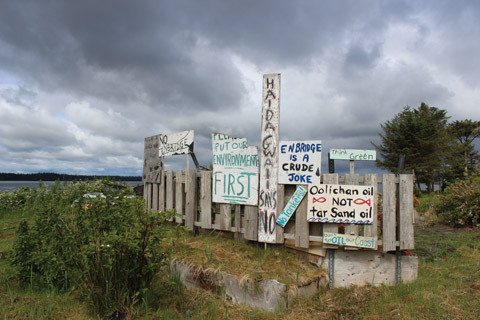
The people of Masset on Haida Gwaii are expressing concerns about the environment in many ways.
In June 2015, David Suzuki and Foundation staff held public events in 12 communities along British Columbia's coast to celebrate, motivate and connect around our shared respect and admiration for the oceans.
From Nanaimo to Masset, Foundation staff were greeted with enthusiasm and thoughtful commentary from more than 3,000 people who shared their concerns and hopes for the oceans. Each event started with a welcome from the local First Nation, and many featured ocean-inspired artwork from students and professional artists. We then screened a 30-minute film by Ian Mauro on climate change in Western Canada.
During intermission we asked people to help us better understand the issues facing coastal communities -- and did they ever respond! We were amazed and inspired by the 700 written submissions, hours of video and audio recordings and comments on whiteboards in the lobby. After David Suzuki gave an inspirational talk, we had a facilitated discussion on themes that emerged from the comments we received.
In every community, people expressed their deep connection to the natural world, along with their observations about long-term shifts in ecosystem health and abundance.
Perhaps even more powerful was the consistent call for the need to work together to ensure future generations have the same ability to experience and enjoy the natural world as we do today.
We will be busy over the next several months summarizing what we heard for the provincial and federal governments, and for the United Nations' periodic review of Canada's Economic, Social and Cultural Rights. We will also report back to the communities we visited so they can hear from each other and share solutions to the common challenges we face.
Hey! Want more DSF? Join David Suzuki on Facebook

St. Lawrence campaign is alive and well
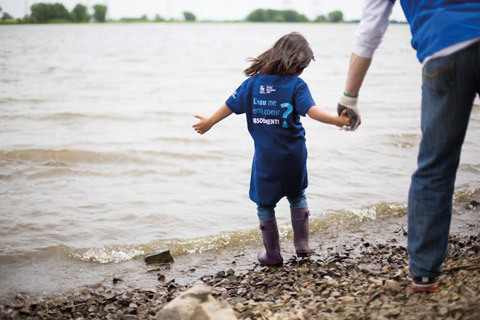
Many people joined the David Suzuki Foundation for the St. Lawrence Week shoreline cleanup.
This summer marked the fifth year of the St. Lawrence: Our Living River annual campaign in Quebec, to raise awareness of "the river that runs through us" -- or, more specifically, through 45 per cent of les Québécois who depend on the river for drinking water.
This year, the third edition of St. Lawrence Week kicked off the June campaign with more than 50 family-friendly activities to encourage citizens to reconnect with the St. Lawrence, made possible with the help of over 40 partners from across la belle province. Activities included fishing workshops, shoreline cleanups and even whale-singing lessons! A few highlights included a visit from world-famous rower and St. Lawrence ambassador Mylène Paquette during our shoreline cleanup and a family rally event on June 7 in Pointe-aux-Trembles, as well as a screening of the movie L'or du golfe, followed by a panel discussion with filmmaker Ian Jaquier and experts from the St. Lawrence Coalition about the devastating impacts of -- and ways to prevent -- oil and gas drilling in the Gulf of St. Lawrence.
Since the first event in 2013, St. Lawrence Week has successfully reconnected tens of thousands of Quebecers to a river that has shaped their history, culture, health and economy. To highlight the latter, the Foundation launched a report in June on the economic value of aquatic ecosystems in Montreal's Bluebelt area, underlining the need to protect the river's fragile ecosystems as well as Quebecers' willingness to contribute to protecting their drinking water.
Finally, throughout June, Foundation supporters were treated to weekly emails with tips to help care for the river, including our list of top 10 sustainable fish and seafood, as well as many fun facts on the river's rich biodiversity and the countless reasons to help protect it, today and for future generations.
Hey! Want more DSF? Join David Suzuki on Facebook

Ontario restricts bee-killing neonic pesticides
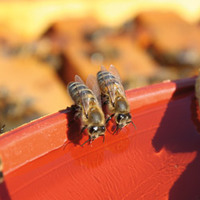
Thanks to more than 25,000 Foundation supporters who sent messages to the government, Ontario's groundbreaking regulatory restrictions on bee-killing neonicotinoid pesticides took effect July 1, 2015. The regulations will reduce the use of seeds treated with neonics, a controversial family of nicotine-based pesticides that has been implicated in the global decline of bees. Ontario is the first jurisdiction in North America to implement restrictions on the agricultural use of neonics.
The regulations follow a landmark study from the international Task Force on Systemic Pesticides, a group of independent scientists that reviewed more than 1,000 published studies about the effects of neonics. The Task Force found clear evidence that neonics are lethal to honeybees and cause a range of harmful effects on other important species such as wild bees, birds, butterflies and earthworms. The authors conclude that current widespread and indiscriminate use of neonics threatens ecosystem functioning and is not sustainable.
Reducing use of neonics in Ontario is a welcome and necessary first step toward banning these harsh, bee-killing chemicals across Canada. And Ontario's determined effort to wean the province from neonics demonstrates that, despite fierce pushback from multibillion dollar companies profiting from pesticide sales, strong science bolstered by public support for protecting pollinators is prevailing.
Hey! Want more DSF? Join David Suzuki on Facebook

Ode to a tree named Jessica
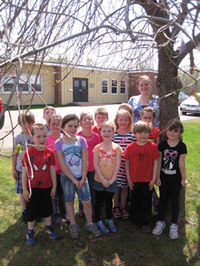
Students at Wentworth gave thanks to their favourite tree as part of the 30X30 Nature Challenge.
This year's 30X30 Nature Challenge reached more than 700 Canadian classrooms from coast to coast to coast. In addition to their 30 days of outdoor activities, classes were asked to adopt a tree in their schoolyards and submit photos and stories to the Foundation. We received dozens of touching tree stories, and it was difficult to pick just one!
Congratulations to the students of Wentworth Consolidated Elementary School in Nova Scotia! Grade 1 and 2 students worked together to tell the story of their favourite tree, Jessica, chosen for her location outside the classroom window at the front of the school.
Given the school's history, students determined that Jessica had been around for a long time and had seen many changes. Their story told of the many friendships Jessica made with other trees and the schoolchildren. One student eventually grew up and stopped visiting Jessica, but many seasons later brought her son to visit and play.
The students included this poem with their story, using their five senses to describe Jessica.
To Jessica
You are tall and strong
Your bark is bumpy and rough
Your sap is sticky and sweet
You help the air stay clean
Your branches are skinny and bendy
Your trunk is nice and sturdy
Your roots like water best
Your buds will grow into leaves
You shelter us from weather
You are our favourite tree!
At the beginning of May, Wentworth Consolidated students brainstormed a list of over 70 outdoor activities they could do throughout the month. They wrote these on stars and stuck them to the wall all over the classroom.
Students also shared their fun outside -- as a class and with their families -- on a wall calendar. By the end of the month, the calendar was completely full!
Way to go!
Hey! Want more DSF? Join David Suzuki on Facebook

Blue Dot passes major milestone
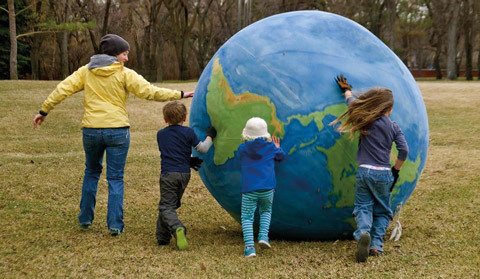
Blue Dot volunteers in Regina helped us get the ball rolling.
As Canadians began enjoying longer, warmer summer days, the Blue Dot movement passed an important milestone. On June 1, our team of volunteers and supporters convinced city council in Kitchener, Ontario, to pass a declaration stating that residents there have the right to live in a healthy environment. On the same day, St. John's, Newfoundland, also passed a declaration -- the first community in Atlantic Canada to do so.
That pushed the growing movement over the five million mark! Now more than 14 per cent of Canadians live in a community that recognizes their right to live in a healthy environment!
More than 75,000 Canadians have signed on to the Blue Dot movement, and over 16,000 volunteers and organizers are helping out. With even more communities getting on-board to recognize the right to live in a healthy environment, it's sometimes hard to find time to step back and celebrate where we are. But there's a lot worth celebrating, thanks to donors and supporters like you.
Since passing the five million mark, we've added cities and towns representing a million more Canadians. With Victoria on the Pacific and St. John's on the Atlantic, Blue Dot is truly a coast-to-coast movement for change!
As success at the community level continues to grow, our long-term plan is starting to crystalize. The groundwork we're laying is putting the idea of environmental rights in front of Canadians in cities and towns across the country.
As we head into the fall, we're looking forward to the next step: convincing provincial and federal leaders to take action.
Preparations have started. We're investing in research and resources, reaching out to political leaders and counting on donors and volunteers from across the country to help us move into the next phase of this exciting endeavour.
Our goal has always been to create a future when all levels of government recognize the right of all Canadians to live in a healthy environment, no matter who they are or where they live.
It's a challenge, but as David Suzuki says, "Things are only impossible until we decide that they're not anymore."
With your continued support, we can come together in this growing movement to protect the people and places we love.
Hey! Want more DSF? Join David Suzuki on Facebook

Finding Solutions - Fall 2015
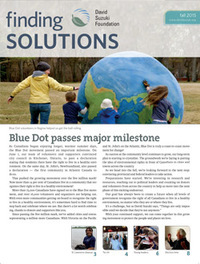
Finding Solutions is our quarterly report to you -- showing your donations at work in our recent victories and campaigns. Plus, it's full of tips, news, recommended books and movies, and ways you can help the environment in your everyday life.
Hey! Want more DSF? Join David Suzuki on Facebook

Deniers are all over the map; climate realists all over the world

Polls and marches, demonstrations and citizen initiatives show that people want action. (Credit: Chris Yakimov via Flickr)
A little over a year ago, I wrote about a Heartland Institute conference in Las Vegas where climate change deniers engaged in a failed attempt to poke holes in the massive body of scientific evidence for human-caused climate change. I quoted Bloomberg News: "Heartland's strategy seemed to be to throw many theories at the wall and see what stuck."
A recent study came to a similar conclusion about contrarian "scientific" efforts to do the same. "Learning from mistakes in climate research," published in Theoretical and Applied Climatology, examined some of the tiny percentage of scientific papers that reject anthropogenic climate change, attempting to replicate their results.
In a Guardian article, co-author Dana Nuccitelli said their study found "no cohesive, consistent alternative theory to human-caused global warming." Instead, "Some blame global warming on the sun, others on orbital cycles of other planets, others on ocean cycles, and so on."
Nuccitelli and fellow researchers Rasmus Benestad, Stephan Lewandowsky, Katharine Hayhoe, Hans Olav Hygen, Rob van Dorland and John Cook note that about 97 per cent of experts worldwide agree on a cohesive, science-based theory of global warming, but those who don't "are all over the map, even contradicting each other. The one thing they seem to have in common is methodological flaws like cherry picking, curve fitting, ignoring inconvenient data, and disregarding known physics."
It's astounding and tragic that, with all the evidence -- from volumes of scientific research to the very real effects we are experiencing everywhere -- some people stubbornly refuse to believe there's a problem worth addressing. Sadder still: Many of them are political leaders.
Part of the problem is that fossil fuel interests spend enormous amounts of money to sow doubt and confusion, often by funding or setting up organizations like the Heartland Institute in the U.S., the Global Warming Policy Foundation in the U.K., Ethical Oil and Friends of Science in Canada and the International Climate Science Coalition, based in this country but affiliated with similar organizations in Australia and New Zealand and with close ties to Heartland. A number of industry-funded websites also promote fossil fuels at the expense of human life, including Climate Depot and Watts Up With That?
These secretive organizations rarely reveal funding sources, prey on the uninformed and ignorant, and blanket the media with opinion articles, letters to editors and comments, often referring to misleading charts and graphs and bogus "studies" from organizations with names that imply they're scientific when they're anything but. They're assisted by a compliant news media and politicians who also receive fossil fuel industry funding. It's likely the people behind these organizations know they're lying but care more about making money and preserving the lopsided benefits of a polluting sunset industry than finding ways to contribute to human health, well-being and survival.
Those who argue that seven billion people pumping massive amounts of greenhouse gases into the atmosphere aren't having a serious negative impact are out to lunch.
Fortunately, most thinking people don't buy the lies. People from all sectors and walks of life -- religious, academic, business, political, activist, social justice and citizenry -- are calling for an urgent response to the greatest threat humanity faces. From Pope Francis and the Dalai Lama to Islamic scholars and Hindu, Sikh and Jewish leaders; from Volvo, Ikea and Apple to the International Monetary Fund, World Bank and World Health Organization; from every legitimate scientific academy and institution to enlightened political leaders -- all have warned about the serious nature of global warming and the urgent need to do something about it.
Polls and marches, demonstrations and citizen initiatives show that people want action. Yet, despite this tremendous recognition of the reality of our situation, governments have failed to come up with a legally binding, ambitious and universal climate agreement, thanks in part to efforts by countries like Canada, Japan and Australia to stall or water down agreements at economic summits and UN climate conferences.
As world leaders prepare for the December UN climate meeting in Paris, Canadians must impress upon all those who hope to govern us after October 19 the importance of making a positive contribution. As voters, we have the power to make a difference in this critical conversation. Let's exercise it.
Hey! Want more DSF? Join David Suzuki on Facebook

September 2, 2015
How to get involved in your local all-candidates' debate
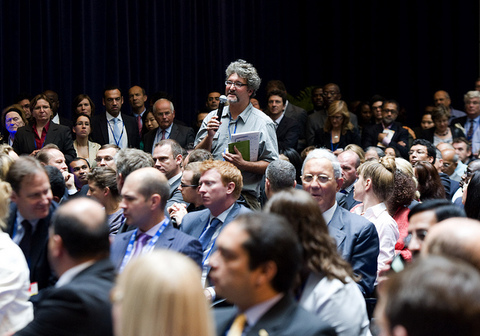
(Credit: IMF via Flickr)
Little plastic signs on lawns? Phone calls asking how you're going to vote? Endless advertising? It must be election season!
For many people, elections can quickly get exhausting -- especially this year, with a campaign more than two months long! But it's also an incredible opportunity to find out more about the people who want to represent us and a chance to get out there in your community and help shape the debate.
Shape the debate? That sounds hard!
Don't worry, it's actually quite easy. Almost every community has one, even several, all-candidates' debates. Some might be open-ended, others may be organized by groups who want to focus on a specific issue. All give you and your neighbours a chance to see the candidates in the flesh and hear what they think about the issues that matter most to your community.
Questions like:
Do you believe Canada should join more than 110 nations in recognizing the right to live in a healthy environment by amending Canada's Charter of Rights and Freedoms?
Canadians subsidize the fossil fuel industry to the tune of $1.3 billion per year despite the fact that the industry is in a downturn, which has destabilized our economy. Will you end these subsidies and encourage a transition to a clean-tech economy? If so, how?
Provinces that have put a price on carbon have seen economic growth that outpaces the Canadian average. Will you enact a national carbon-pricing policy?
Canadians deserve a government that is open, transparent and committed to science. Will you support allowing government scientists to speak freely about their work, opening up review processes to all concerned Canadians and basing decisions on the best available evidence?
Okay, thanks! But how do I find my local all-candidates' debates?
Often, events are listed in local papers, especially community weeklies. But the easiest way to find out is to contact your favourite local candidate's office and ask. Here are links to find candidates:
Bloc candidates
Conservative candidates
Green candidates
Liberal candidates
NDP candidates
I've never gone to an all-candidates' debate before. How do I ask a question?
Usually the group organizing the event says a few words and then turns it over to the panel of candidates. Each usually gets get a few minutes to make an opening statement and then it's time for questions. Often organizers kick things off with questions of their own but eventually request questions from the audience.
There might be microphones set up in the room you can line up at and/or volunteers walking around with portable mics. Either flag someone down or get in line and wait for your turn. When the big moment comes, don't panic! The people in the room are your friends and neighbours, and many of them are interested in the same things you are. Be clear and to the point, and try not to spend too much time explaining who you are or introducing your question. But don't sit down just yet!
Wait at the mic while the candidates answer the question. Someone might ask you for clarification or not answer the question at all. This is your chance to jump in and clarify the question or urge the candidate to be more straightforward! But remember, this isn't a fight. If they won't answer a question, at least you'll know where they all stand on the issue.
Phew! That wasn't so hard! Now what?
Congrats! If you managed to track down a debate, make the time to attend and even ask a question, you're a superstar! We would love to know how it went, so we put together this simple survey to help track responses across the country. Fill it out and we'll send everyone a breakdown of the responses.
Something else interesting happen? Shoot us an email at election2015@davidsuzuki.org and let us know!
All-candidates' debates are exciting and important ways for people like you and me to get to know our candidates better, but also for candidates to hear what's most important to the people they're aiming to represent.
So get out there and ask a few questions! It's not that hard, I promise!
YES, I'm voting on October 19.
Hey! Want more DSF? Join David Suzuki on Facebook

August 31, 2015
How to connect kids with nature
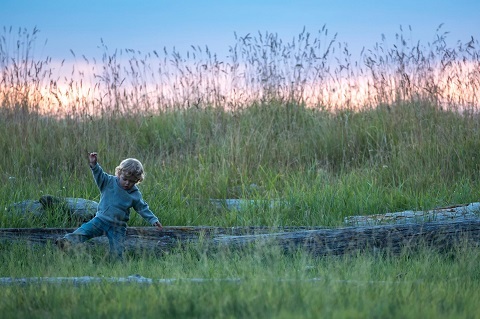
Increase time in nature and take what you normally do inside and do it outside — eat and read! (Credit:Brendon Purdy)
Too many of us treat time outdoors like it's dessert, something only to indulge in once chores are finished and the "to do" list is done (like that ever happens...). Vitamin "N" (for "nature") is essential for healthy human function.
Science shows a daily dose of Vitamin "N" (time outdoors) helps:
Moderate the effect of stressful events (e.g., switching daycares, moving, divorce, etc.)
Improve cognitive function, self-discipline and resilience under stress
Improve impulse control and boost immune function
Reduce obesity, stress and the incidence of clinical depression
Improve academic performance
Decrease blood sugars
Make people more generous
Lower rates of aggression
Combat loneliness
What pill, vitamin, or energy drink can do all that?
Over the last decade, researchers have documented what most of us know intuitively: nature is good for learning, health and well-being. Being regularly immersed in the outdoors can reduce stress and symptoms of attention-deficit disorders AND boost immunity, energy levels and creativity. Plus, children who spend time in nature are far more likely to care about protecting it later in life. (Of course, all of the above applies to caregivers as well as kids, with additional benefits including improved workplace performance and increased job satisfaction.)
Most children are curious explorers, so you don't need to do much to cultivate their nature connectedness -- just take them outside!
The challenge for parents, caregivers and teachers is more about how to get out of their way while keeping them, the plants and critters safe. Here, are five simple ways you and the kids in your life can get a daily dose of Vitamin "N":
1: Watch your language
"Ick." "Ew." "Gross." Adults say those words about nature -- in front of kids -- probably without even realizing it. Try not to squelch curiosity about nature. Instead, teach kids about touching, holding and exploring nature safely. Some things to suggest:
Toilet tissue or a cup and paper can help relocate spiders.
Leave some snails behind to work in the garden and for other kids to find.
No slugs in the hand (the sticky slime is impossible to get off).
Bees are fun to watch, not touch.
Ant hills are best observed from a distance.
Caterpillars need to be released to morph into butterflies or moths.
Wasps and bees need space because they can sting.
2: Read and eat outside
Sometimes the easiest way to increase time in nature is to take what you normally do inside and do it outside! Host story time or snack/lunch time on the grass or under a tree.
3: Make a nature discovery kit
To a reusable cloth bag, add: a bug bungalow or a mason jar with air holes (much better than pockets), a butterfly net, a magnifying glass and a dip net (to explore streams and ponds). Then head for a local park, beach or boulevard.
4: Plan a scavenger hunt
Grab a few brown paper bags (one per child or team) to fill with the suggested items. Search for colours, shapes and objects e.g., "something smooth, oval and red". Items could start with different letters of the alphabet, or even spell a child's name -- a great birthday party activity!
5: Make a bee bath
Busy bees get thirsty. But they're crash landers! Open water, like a creek or pond (even a bird bath) means bees risk drowning. Help them get a drink of water and prevent drownings:
Place a shallow plate in your yard or garden at ground level where you've noticed bee activity.
Add a few rocks to the plate to create landing pads or islands.
Add fresh water but don't submerge the stones.
Refill as needed.
To realize the full benefits of time spent in nature, turn off your cell phone ringer that sounds like a bird or cricket and listen for the real thing!
Nature is calling. Will you answer?
Sincerely,
Lindsay Coulter, David Suzuki's Queen of Green
Hey! Want more DSF? Join David Suzuki on Facebook

David Suzuki's Blog
- David Suzuki's profile
- 247 followers



